
La Earthcache / The Earthcache
► Contexte géologique local
Le bassin de Saint-Paul-de-Fenouillet se situe dans la partie nord-est de la Zone Nord Pyrénéenne et est une région de transition entre les Corbières et le Fenouillèdes.
L'orogenèse pyrénéenne a complètement transformé cette région constituée de formations sédimentaires du Mésozoique en un ensemble de plis anticlinaux ou synclinaux, formant un relief d’ensembles ondulés.
► Synclinal ou Anticlinal, une histoire de pli.
Initialement horizontales, les roches sédimentaires litées sous une régime compressif (contexte orogénétique) vont se plier avec des amplitudes allant du centimètre au décakilomètre.
Les plis d'une roche litée se caractérisent par un pendage constitué de deux valeurs :
- l'inclinaison des lits par rapport à un plan à l'horizontale, exprimée en degrés.
- la direction du pendage, angle par rapport au Nord du plan horizontal (voir schéma).
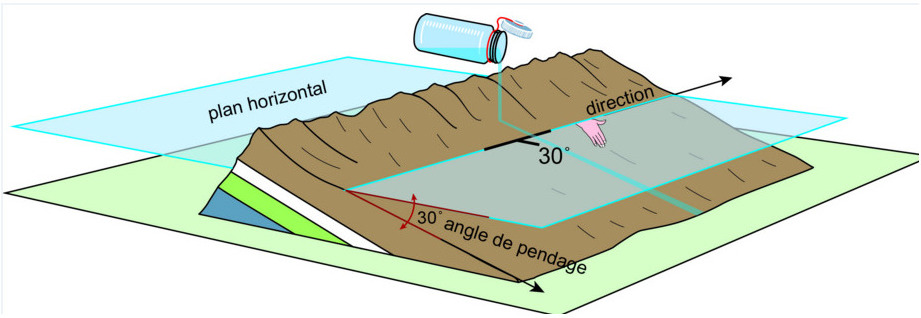
Les plus grandes de ces formations plissées prennent le nom de synclinal ou d'anticlinal :
- Dans un synclinal, les strates se présentent en “creux de vague” (pli concave). Plus on va vers le centre du synclinal et plus les couches stratigraphiques sont jeunes.
- Dans un anticlinal, les strates se présentent en “haut de vague” (pli convexe). Plus on va vers le centre de l'anticlinal et plus les couches stratigraphiques sont anciennes.
La position dans un mégapli se détermine par l'inclinaison des strates : les couches à la charnière du pli ont une inclinaison subhorizontale, alors que celles sur les flancs sont beaucoup plus inclinées.
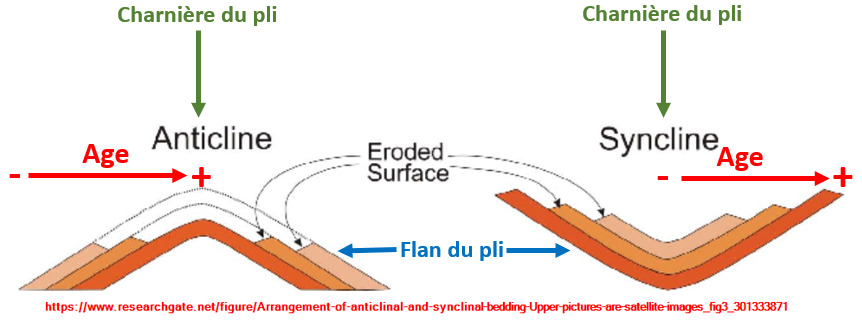
► Le Synclinal du Fenouillèdes
~ Caractéristiques et mise en place
Le synclinal du Fenouillèdes est un synclinal calcaire long de 40 km et large de 6 à 7 km en moyenne.
Son histoire commence au Mésozoïque pendant une longue période d'immersion de près de 200 millions d'années (du Trias, -240 MA, au Crétacé, -85 MA), calme, sans surrection de nouvelles montagnes, qui voit s'accumuler d'énormes épaisseurs de sédiments au fond des mers.
Puis la plaque ibérique vient se rapprocher de la plaque eurasiatique et à partir de 40 millions d'années entre en collision avec elle.
Ce contact brutal dégage des forces colossales qui compressent et déforment les formations sédimentaires en place, initiant l'orogenèse pyrénéenne.
Les compressions se faisant selon un axe Nord-Sud (axe de déplacement des plaques), les déformations vont provoquer des reliefs très prononcés (succession d'anticlinaux et de synclinaux) ayant une charnière Ouest-Est, dont l'imposant synclinal du Fenouillèdes.
~ Un synclinal, des roches
Malgré une période de forte érosion due à la surrection des Pyrénées au Cénozoïque, le synclinal est toujours caractérisé par deux formations calcaires du Crétacé.
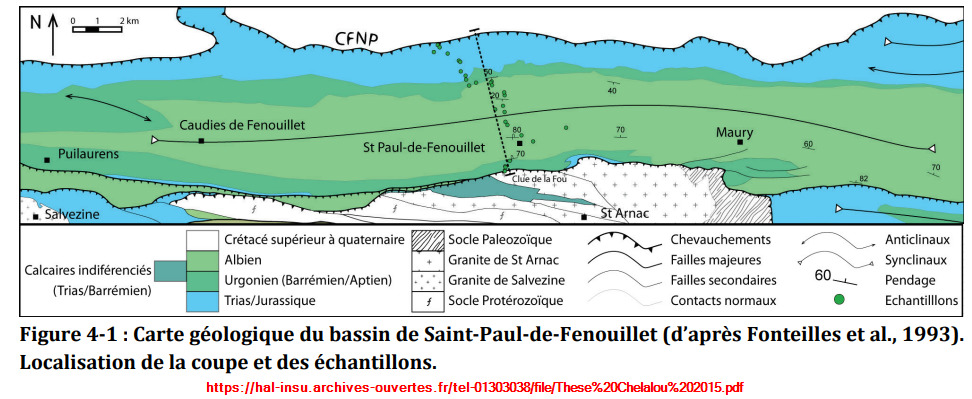
Le Crétacé est la troisième et dernière période géologique de l'ère Mésozoïque.

- Les calcaires massifs du Valanginien forment des crêtes rocheuses et des pics qui s'enchaînent et composent une remarquable toile de fond complexe qui accentue la profondeur des paysages. Il s'agit de calcaires purs compacts et massifs de couleur gris clair, à strates d'épaisseur importantes (décamétriques), sans fossile et à texture fine. Ils sont durs (non rayables à l'ongle).
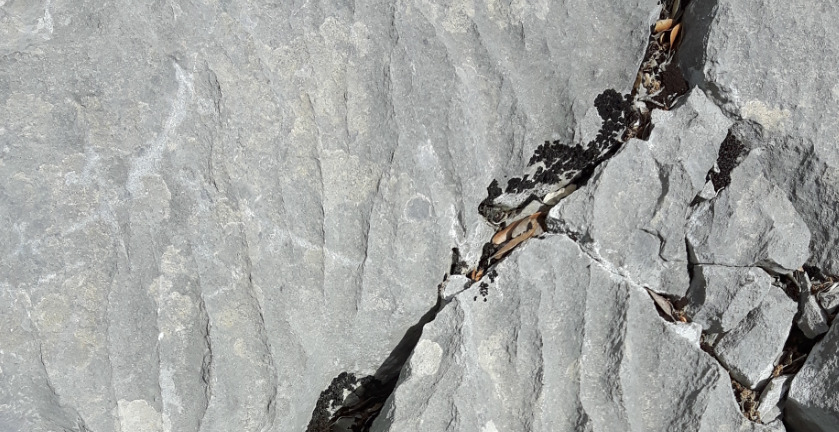
- Les marnes noires de l'Albien sont des formations beaucoup plus tendres, finement litées en feuillets, de couleur très sombre. Elles ont une texture très fine.
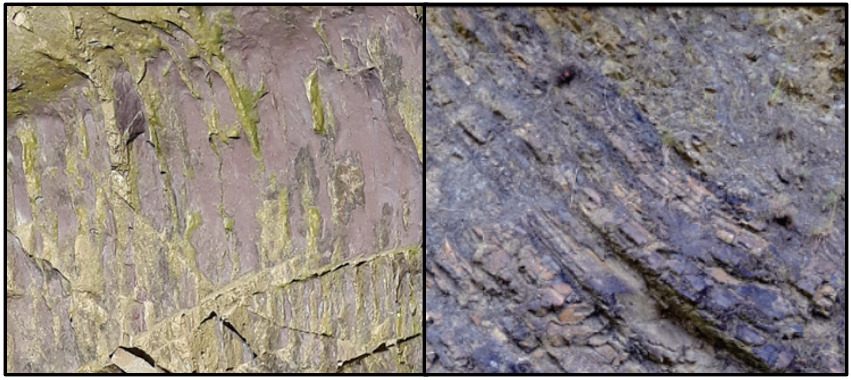
► Local geological context
The Saint-Paul-de-Fenouillet basin is located in the northeastern part of the North Pyrenean Zone and is a transition region between Corbières and Fenouillèdes.
The Pyrenean orogeny completely transformed this region made up of Mesozoic sedimentary formations into a set of anticlinal or synclinal folds, forming a relief of undulating sets.
► Synclinal or Anticlinal, a fold story.
Initially horizontal, the sedimentary rocks bedded under a compressive regime (orogenetic context) will bend with amplitudes ranging from centimeter to decakilometer.
The folds of a bedded rock are characterized by a dip made up of two values:
- the inclination of the beds with respect to a horizontal plane, expressed in degrees.
- the direction of the dip, angle with respect to the North of the horizontal plane (see diagram).
The largest of these folded formations take the name of syncline or anticline:
- In a syncline, the strata appear in a “trough” (concave fold). The more we go towards the center of the syncline, the younger the stratigraphic layers.
- In an anticline, the strata appear at the “top of the wave” (convex fold). The further you go towards the center of the anticline, the older the stratigraphic layers.
The position in a mega-fold is determined by the inclination of the strata: the layers at the hinge of the fold have a sub-horizontal inclination, while those on the sides are much more inclined.
► The Fenouillèdes Syncline
~ Characteristics and installation
The Fenouillèdes syncline is a limestone syncline 40 km long and 6 to 7 km wide on average.
Its history begins in the Mesozoic during a long period of immersion of nearly 200 million years (from the Triassic, -240 MA, to the Cretaceous, -85 MA), calm, without the uplift of new mountains, which sees the accumulation of 'enormous thicknesses of sediment at the bottom of the sea.
Then the Iberian plate comes closer to the Eurasian plate and from 40 million years ago collides with it.
This brutal contact releases colossal forces which compress and deform the sedimentary formations in place, initiating the Pyrenean orogeny.
The compressions being done along a North-South axis (axis of displacement of the plates), the deformations will cause very pronounced reliefs (succession of anticlines and synclines) having a West-East hinge, including the imposing Fenouillèdes syncline.
~ One syncline, Severals rocks
Despite a period of strong erosion due to the uplift of the Pyrenees in the Cenozoic, the syncline is still characterized by two limestone formations of the Cretaceous.
The Cretaceous is the third and last geological period of the Mesozoic era.
- The massive limestones of the Valanginian form rocky ridges and peaks which follow one another and compose a remarkable complex backdrop which accentuates the depth of the landscapes. These are pure, compact and massive limestones of light gray color, unrelated, fossil-free and with a fine texture. They are hard (not scratched with the fingernail).
- The black marls of the Albian are much softer formations, finely bedded in sheets, of a very dark color. They have a very fine texture.
► Sources bibliographiques / Bibliographical sources
Les Questions / The Questions
Questions pour valider :"Le synclinal du Fenouillèdes"
Questions to validate: "The Fenouillèdes syncline"
- Question 0 : Prenez une photo de vous ou d'un élément vous appartenant avec la table orientation et le synclinal du Fenouillèdes en arrière plan.
Cette photo devra au choix nous être transmise avec les réponses ou être ajoutée à votre log.
-Question 0 : Take a picture of yourself or of an element belonging to you with the orientation table and the Fenouillèdes syncline in the background.
This photo must either be sent to us with the answers or added to your log.
Observez la crête rocheuse sur votre gauche depuis le point de vue (photo WP1).
Observe the rocky ridge on your left from the viewpoint (photo WP1).
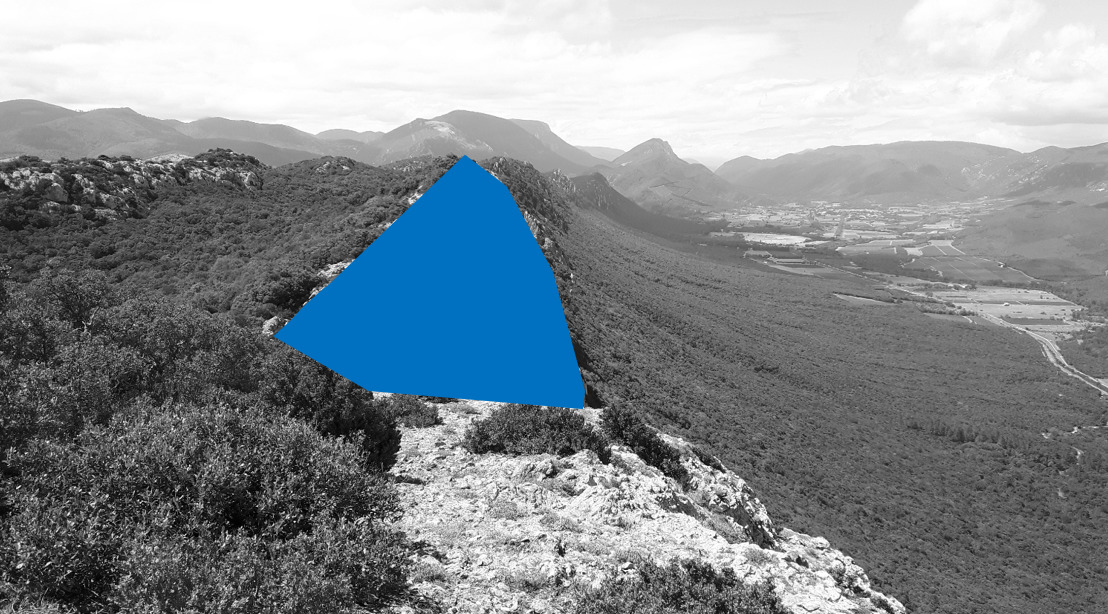
- Question 1 : Déterminez les caractéristiques du pendage des couches de la zone bleue.
- L'orientation de ce pendage est-il cohérent avec la tectonique locale (justifier votre réponse) ?
- D'après son inclinaison, à quel endroit du synclinal vous trouvez-vous ?
- Question 1: Determine the dip characteristics of the layers of the blue zone.
- Is the orientation of this dip consistent with the local tectonics (justify your answer)?
- Based on its incline, where in the syncline are you?
- Question 2 : Décrivez les affleurements rocheux au sol à droite de la table d'orientation. De quelle roche est constituée la zone où vous vous trouvez et quelle âge géologique a-t-elle ? Est-elle plus ancienne ou plus jeune que l'autre formation principale de cette zone ?
- Question 2: Describe the rocky outcrops on the ground to the right of the orientation table. What rock is the area you are in and how old is it geologically? Is it older or younger than the other main formation in this area?
- Question 3 : En considérant la vue devant vous, vos réponses à la question précédente et les éléments du descriptif, expliquez pourquoi vous avez devant vous un synclinal et non un anticlinal.
- Question 3: Considering the view in front of you, your answers to the previous question and the elements of the description, explain why you have before you a syncline and not an anticline.
Vous pouvez vous loguer sans attendre notre confirmation,
mais vous devez nous envoyer les réponses en même temps soit par mail via notre profil (
fafahakkai), soit via la messagerie geocaching.com (Message Center).
S'il y a des problèmes avec vos réponses nous vous en ferons part.
Les logs enregistrés sans réponse seront supprimés.
You can log this cache without waiting for our confirmation, but you must send us the answers at the same time, by e-mail via our profile (fafahakkai) or by the system of Message Center of geocaching.com.
If there is a problem with your answers we will notify you. The logs recorded without answers will be deleted.
Rappel concernant les « Earthcaches »: Il n'y a pas de conteneur à rechercher ni de logbook à renseigner. Il suffit de se rendre sur les lieux, de répondre aux questions ci-dessus et de nous renvoyer les réponses.
Reminder concerning "Earthcaches": there is neither a container to look for nor a logbook to sign. One need only go to the location, answer to the differents questions and send us the answers.